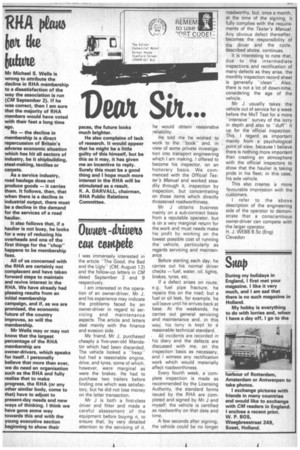Oman -cbtiveta caa emote
Page 69

If you've noticed an error in this article please click here to report it so we can fix it.
I was immensely interested in the article The Good, the Bad and the Ugly" (CM, August 12) and the follow-up letters in CM dated September 2 and 9 respectively.
I am interested in the operation of an owner-driver, Mr J, and his experience may indicate the problems faced by an owner-driver in regard to servicing and maintenance aspects. The article and letters deal mainly with the finance and evasion side.
My friend, Mr J, purchased cheaply a five-year-old Mandator which had been discarded. The vehicle looked a -heap" but had a reasonable engine, drive, and tyres, some of which, however, were marginal as were the brakes. He had to purchase two trailers before finding one which was satisfactory, but he did not lose money on the latter transaction.
Mr J is both a first-class driver and fitter and made a careful a§sessment of the equipment before buying it, to ensure that, by very detailed attention to the servicing of it, he would obtain reasonabie reliability.
He told me he wished to work to the "book" and, in view of some private investigation into transport engineering which I am making. I offered to become his inspector, on an honorary basis. We commenced with the Official Tester's Manual and worked steadily through it, inspection by inspection, but concentrating on those items which directly threatened roadworthiness.
Mr J obtains business mainly on a sub-contract basis from a reputable operator, but is on a very marginal return for the work and must needs make his profit by working on the lowest possible cost of running the vehicle, particularly as regards servicing and maintenance.
Before starting each day, he carries out his normal driver checks fuel, water, oil, lights, brakes, tyres, etc.
If a defect arises on route, e.g. fuel pipe fracture, he repairs this on the road; but a fuel or oil leak, for example, he will leave until he arrives back at base. At the weekends, he carries out general servicing and maintenance and, in this way, his lorry is kept to a reasonable technical standard.
• All incidents are recorded in his diary and the defects are discussed with me, on the inspection basis as necessary, and I witness any rectification work which would materially affect roadworthiness.
Every fourth week, a complete inspection is made as recommended by the Licensing Authority, the standard forms issued by the RHA are com pleted and signed by Mr J and myself; the vehicle is certified as roadworthy on that date and time.
A few seconds after signing, the vehicle could be no longer roadworthy, but, once a month, at the time of the signing, it fully complies with the requirements of the Tester's Manual. Any obvious defect thereafter, becomes the responsibility of the driver and the cycle, described above, continues.
It is interesting to note that, due to the intermediate inspections and rectification of many defects as they arise, the monthly inspection record sheet
is generally "clean-. Also, there is not a lot of down-time, considering the age of the vehicle.
Mr J usually takes the vehicle out of service for a week before the MoT Test for a more "intensive" survey of the lorry in depth and also to "duff" it up for the official inspection.
This, I regard as important mainly from a psychological point of view, because I believe there is nothing more important than creating an atmosphere with the official inspectors to show that the haulier is taking pride in his fleet; in this case, his sole vehicle.
This also creates a more favourable impression with the customers.
I refer to the above description of the engineering side of the operator to demonstrate that a conscientious owner-driver can compete with the larger operator.
H. J. WEBB B.Sc (Eng) Cl eyed on
































































































































